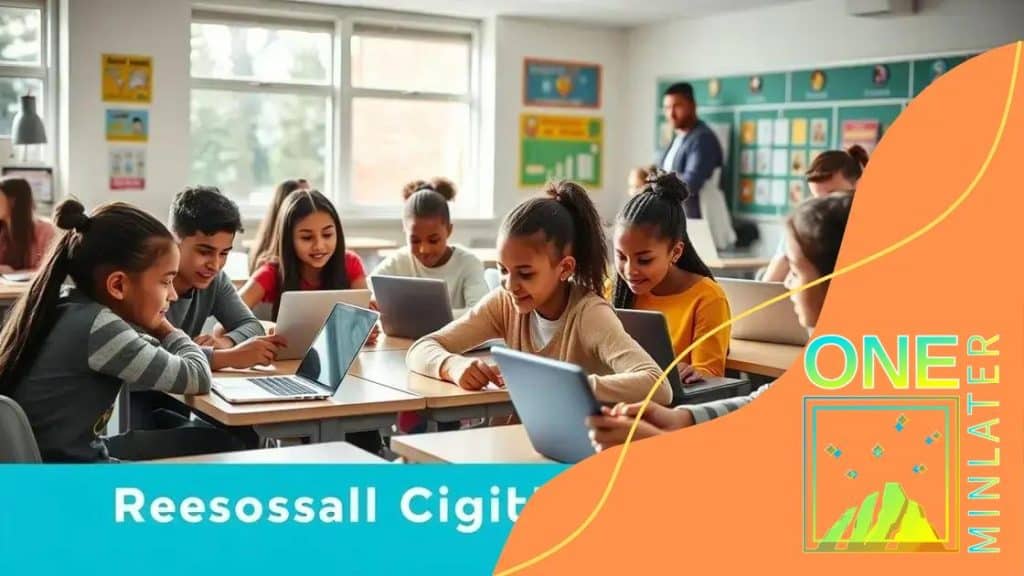How digital citizenship is becoming a school curriculum standard

Digital citizenship is essential in education as it equips students with the knowledge and skills to navigate online environments safely, emphasizing ethical behavior, online safety, and responsible communication in the digital age.
How digital citizenship is becoming a school curriculum standard is a question on many educators’ minds today. As our world becomes increasingly digital, it’s vital for students to navigate these waters effectively. Have you considered how this could impact the future of education?
Understanding digital citizenship
Understanding digital citizenship is crucial in today’s technology-driven society. As students interact more with digital environments, knowing how to behave online becomes essential.
Digital citizenship encompasses a variety of principles, including respect, responsibility, and online etiquette. It’s about understanding the rights and responsibilities of being a digital member of society.
Core Principles of Digital Citizenship
Many aspects contribute to effective digital citizenship. Here are some core principles:
- Digital Communication: Understanding how to communicate effectively online is vital. Students must learn to express themselves clearly and respectfully.
- Online Safety: It’s essential for students to protect their personal information and understand the dangers of online interactions.
- Digital Literacy: Being digitally literate means knowing how to find and assess information online. This skill is crucial for navigating the vast amounts of content available.
- Ethical Use of Technology: Students should learn to respect others’ work and ideas. Understanding copyright and plagiarism is part of this principle.
As we navigate through the digital landscape, it’s critical to encourage positive contributions. Engaging in discussions and sharing knowledge can lead to a more informed community. Furthermore, fostering a sense of empathy in online communication allows for respectful interactions.
The Importance of Digital Citizenship in Education
Incorporating digital citizenship in education prepares students for the future. It equips them with the necessary skills to participate actively in their communities and beyond. It also promotes a safer online environment, reducing instances of cyberbullying.
When schools address digital citizenship, they are investing in their students’ futures. By teaching responsibility and fostering critical thinking, educators can help students navigate the complexities of the digital world with confidence.
The role of technology in education
The role of technology in education is more important than ever. With the rise of digital tools, classrooms are transforming into dynamic learning environments.
Technology enhances the way students learn by providing resources and opportunities for deeper understanding. For example, online platforms offer access to vast information that can engage students.
Benefits of Technology in Education
Integrating technology in education brings numerous advantages for both teachers and students:
- Personalized Learning: Students can learn at their own pace, with tools that cater to their individual needs.
- Interactive Learning: Technology offers interactive resources, making learning more engaging.
- Collaboration: Digital tools enable students to work together, no matter where they are located.
- Access to Information: With the internet, students can find diverse resources, helping them expand their knowledge.
As we embrace technology in education, it is crucial to train teachers to use these tools effectively. By providing professional development, educators can learn to incorporate technology into their lesson plans. This training helps them to guide students in using digital tools responsibly.
Moreover, fostering a culture of innovation can inspire students. When technology is integrated well, it opens new avenues for creativity and critical thinking. Students learn not just to consume information but to analyze and apply it.
Challenges of Technology in Education
While technology has many benefits, there are challenges to address. It’s essential to ensure that all students have access to technological resources, as disparities can create gaps in learning. Additionally, teachers must navigate distractions that come with digital tools.
Balancing screen time with traditional learning methods is important. Integrating technology should enhance education, not replace valuable face-to-face interactions. Working towards a harmonious blend of both methods can optimize the learning experience for students.
Implementing digital citizenship in schools

Implementing digital citizenship in schools is key to preparing students for success in the digital world. Schools play a vital role in teaching students how to navigate the online landscape safely and responsibly.
To start, schools should integrate digital citizenship into their curriculum. This integration ensures that every subject addresses the importance of ethical behavior, online safety, and respectful communication. When students understand these concepts, they are more likely to practice them.
Strategies for Effective Implementation
There are several effective strategies schools can use to teach digital citizenship:
- Professional Development for Teachers: Teachers should receive training on digital citizenship topics so they can effectively educate their students.
- Curriculum Integration: Schools should infuse digital citizenship lessons across subjects, making it a natural part of everyday learning.
- Student-Led Initiatives: Encourage students to take the lead in promoting digital citizenship through projects and campaigns.
- Parental Involvement: Engage parents in discussions about digital citizenship to reinforce the values taught at school.
Creating a positive classroom culture is also essential. Students should feel safe discussing their online experiences and asking questions. Teachers can facilitate this by leading discussions on real-world scenarios, helping students analyze how to respond appropriately.
In addition to classroom instruction, schools can use technology to enhance learning about digital citizenship. Online workshops, simulations, and interactive games can help students learn by doing. These engaging activities make it easier for students to understand complex ideas.
Assessing Understanding
It’s important for schools to assess students’ understanding of digital citizenship. This can be done through quizzes, projects, and discussions. Regular assessments help identify areas for improvement and reinforce key concepts. Schools can also encourage peer feedback, allowing students to learn from one another.
Finally, fostering a school-wide commitment to digital citizenship will involve continuous reflection and adaptation. By keeping up with new technologies and trends, educators can ensure that their teachings remain relevant.
Challenges in teaching digital citizenship
Challenges in teaching digital citizenship are significant, and addressing them is essential for effective education. Educators face various obstacles in ensuring students understand how to behave responsibly online.
One of the primary challenges is keeping up with the rapidly changing technology landscape. New apps, social media platforms, and online trends emerge regularly, making it difficult for teachers to stay informed. This constant evolution means that lessons may quickly become outdated, leaving students unprepared.
Common Issues in Digital Citizenship Education
There are several issues educators must tackle when teaching digital citizenship:
- Varied Levels of Student Knowledge: Students enter classrooms with different experiences and knowledge about technology, making it hard to find a one-size-fits-all approach.
- Lack of Resources: Not all schools have access to sufficient materials or training programs to teach digital citizenship effectively.
- Parental Involvement: Sometimes, parents may not fully understand digital citizenship issues. This lack of support can hinder students’ learning at home.
- Distractions from Technology: While technology aids learning, it also presents distractions that can interfere with focus during lessons.
Another important aspect is engaging students in meaningful discussions. Sometimes, students may not see the relevance of digital citizenship in their lives. Teachers need to illustrate real-world scenarios that highlight the importance of responsible online behavior. Doing so can encourage students to take digital citizenship seriously.
The challenge of assessing students’ understanding also exists. Traditional testing methods may not effectively gauge how well students grasp these concepts. Educators might need to explore creative assessment methods, such as projects or presentations, to evaluate students’ abilities critically.
Creating a Supportive Environment
To overcome these challenges, creating a supportive classroom environment is vital. Open dialogues about online experiences can promote understanding. Teachers should encourage questions and discussions about technology’s impact on students’ lives. Also, involving parents in the conversation can provide a more comprehensive approach to digital citizenship education.
Ultimately, challenges in teaching digital citizenship require innovative solutions and a commitment to staying informed. By addressing these obstacles, educators can better prepare students for responsible digital engagement.
Future trends in digital citizenship education
Future trends in digital citizenship education are essential to understanding how education will adapt to a constantly evolving digital world. As technology continues to change, so do the methods for teaching students about responsible online behavior.
One important trend is the emphasis on social emotional learning (SEL). Schools are increasingly recognizing the value of emotional intelligence in digital interactions. By teaching students to be aware of their feelings and the feelings of others, educators can foster a culture of empathy and respect online.
Integrating New Technologies
Another trend is the integration of new technologies in the classroom. This includes the use of virtual reality (VR) and augmented reality (AR) to create immersive learning experiences. These technologies make it easier for students to understand the consequences of their online actions and the importance of digital citizenship.
- Real-World Simulations: VR and AR can simulate real-world scenarios that require students to navigate complex decisions online.
- Interactive Learning: Using gamified learning experiences can motivate students to learn about digital citizenship in a fun and engaging way.
- Increased Collaboration: Technology allows students to work together on projects related to online ethics and safety.
Furthermore, as mobile devices become more prevalent, digital citizenship education will need to address mobile safety. Schools will emphasize teaching students about the risks of sharing personal information and how to protect their digital footprints. With increasing use of social media, these lessons will help students build a positive online presence.
Focus on Lifelong Learning
Future trends also point toward a focus on lifelong learning. Digital citizenship will not just be taught in schools but will become a continuous practice. Educators will work with students to develop skills that will help them adapt to new technologies throughout their lives.
Collaboration between schools, parents, and communities will be crucial for promoting digital citizenship. Engaging with parents will help reinforce lessons, ensuring that students receive consistent messages about responsible online behavior.
In conclusion, as education systems adapt to technological advances, preparing students to be responsible digital citizens will remain a high priority. Embracing these future trends can lead to meaningful change in how digital citizenship is taught.
FAQ – Frequently Asked Questions about Digital Citizenship Education
Why is digital citizenship important for students?
Digital citizenship is crucial for helping students navigate the online world safely and responsibly, equipping them with skills to act ethically and positively in digital environments.
What are some effective strategies to teach digital citizenship?
Effective strategies include integrating it into the curriculum, using technology like VR for immersive experiences, and encouraging student-led initiatives to promote responsible online behavior.
How can parents support their children’s digital citizenship education?
Parents can support their children’s education by engaging in discussions about online safety, reinforcing lessons taught in school, and modeling positive digital behavior themselves.
What challenges do educators face in teaching digital citizenship?
Educators face challenges such as keeping up with rapidly changing technology, engaging students who may not see the relevance, and addressing varied levels of tech knowledge among students.





